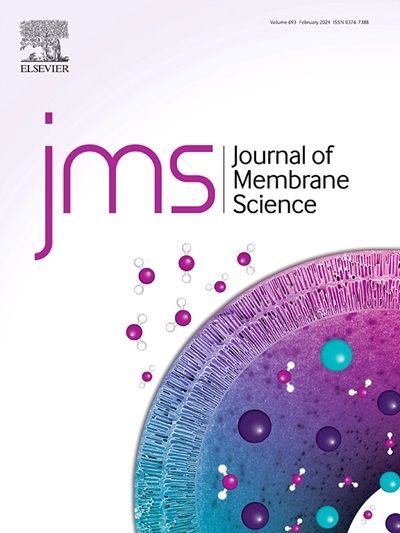Arming nanofibers with MnO2 nanosheets for fast and durable removal of ozone and particulate matter from air
IF 8.4
1区 工程技术
Q1 ENGINEERING, CHEMICAL
引用次数: 0
Abstract
Indoor air pollution, including particulate matter (PM) and ozone (O3), is a significant threat to public health. Membrane separation is considered to be an effective strategy to control air pollutants. However, the development of multifunctional membrane for efficiently eliminating PM and O3 remains challenging. Herein, upon a simple one-step hydrothermal reaction, Cl-doped MnO2 nanosheets were assembled onto electrospun nanofibrous membranes to achieve effective air purification of PM and O3 with low resistance. The MnO2 composed of layered ultrathin nanosheets increased the particle attachment points, and enriched the pore structure and roughness of nanofibers, thereby achieving excellent filtration efficiency of PM0.3 (>95 %) and maintaining low pressure drop (40 Pa). In addition, the introduction of Cl element in PI/MnO2 (PI/MnO2–Cl) nanofibrous membranes created a large specific surface area, high redox property, and abundant water-resistant oxygen vacancy (Ov), which accelerated the desorption of intermediates and reduced the water adsorption during O3 conversion. Notably, the optimized catalytic membranes exhibited a stable O3 decomposition efficiency of 94.5 % under a relative humidity (RH) of 90 %. This work provides a potential new strategy to fabricate modified MnO2-based dual-function nanofibrous membranes for PM trapping and O3 decomposition with sustained low airflow resistance.

求助全文
约1分钟内获得全文
求助全文
来源期刊

Journal of Membrane Science
工程技术-高分子科学
CiteScore
17.10
自引率
17.90%
发文量
1031
审稿时长
2.5 months
期刊介绍:
The Journal of Membrane Science is a publication that focuses on membrane systems and is aimed at academic and industrial chemists, chemical engineers, materials scientists, and membranologists. It publishes original research and reviews on various aspects of membrane transport, membrane formation/structure, fouling, module/process design, and processes/applications. The journal primarily focuses on the structure, function, and performance of non-biological membranes but also includes papers that relate to biological membranes. The Journal of Membrane Science publishes Full Text Papers, State-of-the-Art Reviews, Letters to the Editor, and Perspectives.
 求助内容:
求助内容: 应助结果提醒方式:
应助结果提醒方式:


